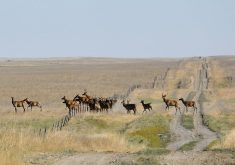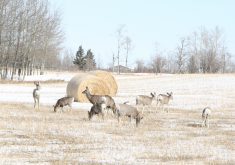A bow hunter was walking parallel grid lines in a canola field. A guy drove by and asked what he’d lost.
“I shot a deer in those trees. It must have dropped somewhere in this field.”
The passer-by replied: “I have two bird dogs with me. Let’s let them try.”
They started the dogs downwind of the presumed blood trail and the dogs found the deer in minutes.
Later, when the relieved hunter was told that what he had done was illegal, he was flabbergasted. Why should this be illegal? No one was hurt. Less crop was trampled with the dogs’ help.
Read Also

High prices see cow-calf producers rushing to incorporate
Farm accountants are reporting a steady stream of cow-calf producers rushing to get their operations incorporated ahead of selling their calves this fall.
“I’m supposed to make every effort to recover shot game, that’s what we did.”
Andy Bensing, a member of unitedbloodtrackers.org/, describes U.S. trends that likely apply equally well to Canada.
“Blood-tracking dogs, as they are typically called, even though they don’t need blood present, have always been legal for use in the past. However, around the beginning of the 20th century, most of the United States outlawed the use of dogs for deer hunting. Over-hunting of white-tailed deer by market hunters using dogs to actually hunt, not just recover deer, is often cited as the cause of the ban.
“ The use of blood tracking dogs stayed illegal in all but a few southern states for the next 80 years or so until a movement for their use got started in New York in 1976. Once New York legalized the use of leashed tracking dogs for wounded deer recovery in 1985, six other states followed suit over the next few years, but then things stayed quiet until about 10 years ago.”
While the practice is expanding south of the border, the Prairie provinces are far behind.
Saskatchewan hunting dog clubs submitted a resolution for blood tracking at the Saskatchewan Wildlife Federation’s 95th annual general meeting in Saskatoon. Eighty-one per cent of the 240 attendees endorsed a call for a regulatory change to allow leashed blood tracking.
The word “leashed” is in our resolution — and we meant it. Most trackers use a 10 metre bright-orange leash that is held mid-way. It can be dropped when a dog goes through a thicket and picked up again at the other end.
The leash makes compliance easy to enforce and is crucial for success. Dogs tend to move too fast and may miss a turn in track direction. Leashed teamwork also ensures dog safety.
Police use dogs for tracking and drug sniffing. Then there are hunting dogs that know how to track pheasants and deer. On top of that, people likely underestimate what their Border Collie or most any breed owned by 58 per cent of Canadian families could do. These too can put their 300 million smell receptors to work to find shot big game.
A bit of preparation for a family dog would help. Save venison blood or use minced hamburger diluted with water. Dribble or dab with a sponge at the end of a stick every step or two leading to a wiener for reward and watch your dog catch on to that game.
Truth be told, our conservation officers have a tough job already. Judging from office/program closures and budgets that don’t always keep up with inflation, their reluctance to take on more regulation drafting is understandable. Yet, many Canadian provinces have wording that works — there is no need to reinvent the wheel. Let’s get the job done for hunters, for venison on the dinner table and for ethical hunting. Only the coyotes will be unhappy.
Joe Schmutz has hunted with, bred and judged hunting dogs in field tests for more than 40 years. He is a biologist by profession and is retired from the University of Saskatchewan.














